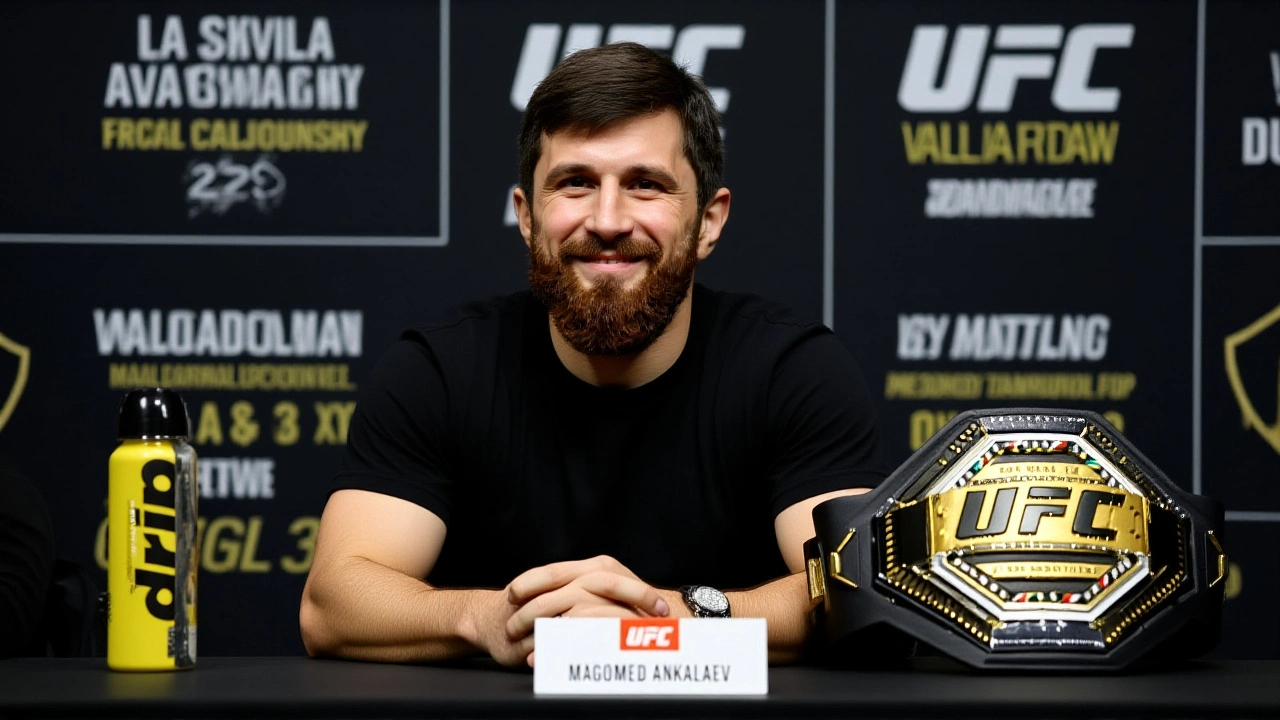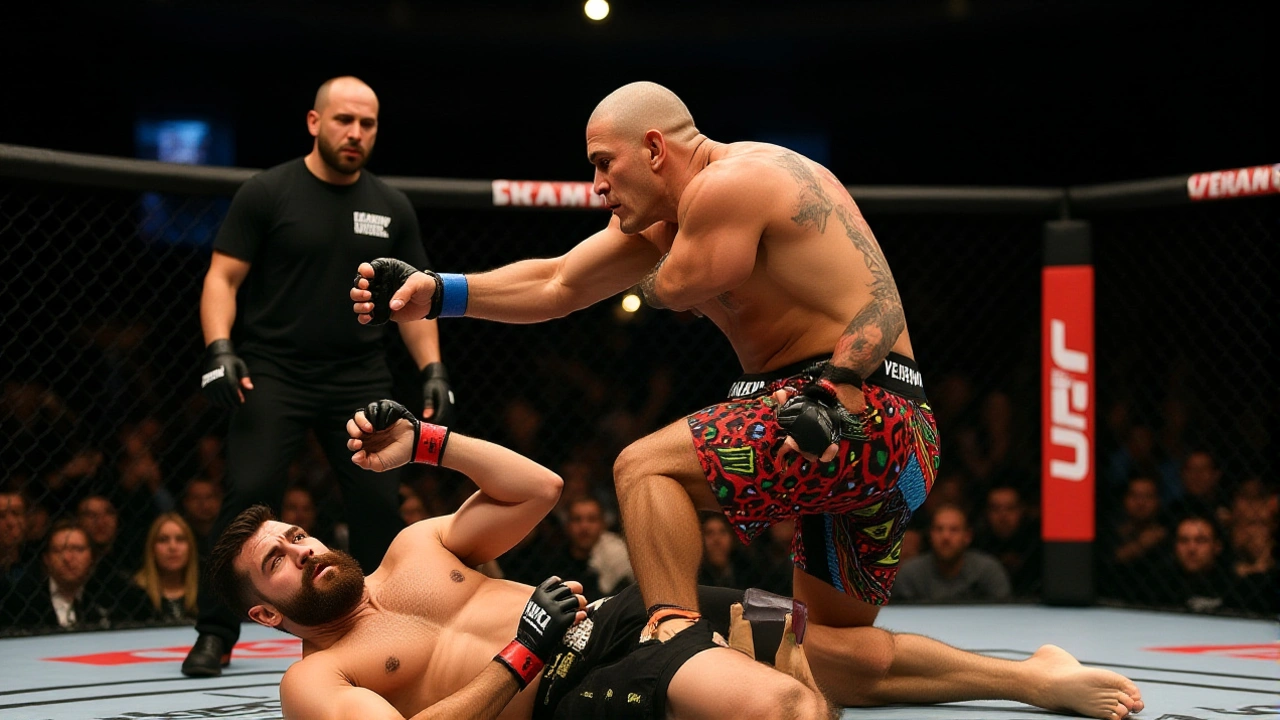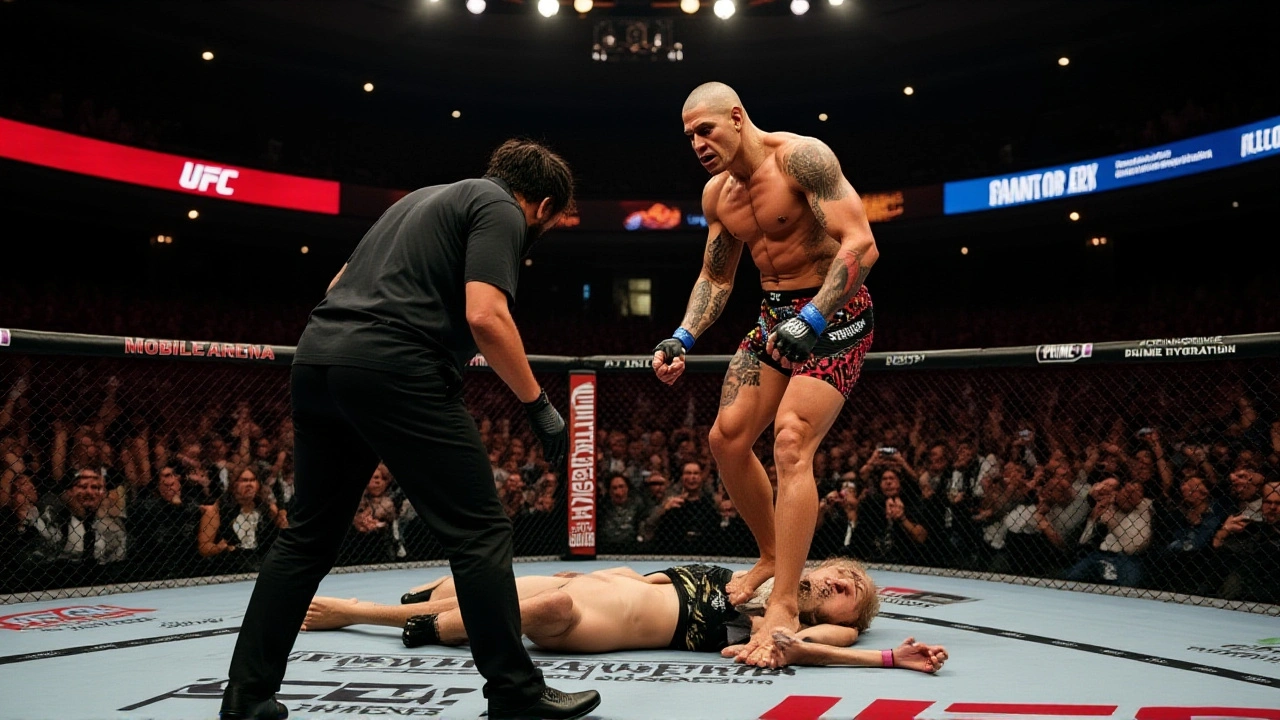UFC 320 Payouts: Pereira, Ankalaev, Dvalishvili Set for Multi‑Million Paydays

When Alex Pereira, the UFC light‑heavyweight champion, steps back into the Octagon at T-Mobile Arena for the UFC 320Las Vegas, the buzz isn’t just about the fight – it’s about the money. Both Pereira and his challenger Magomed Ankalaev are projected to earn roughly $3 million each, a figure that underscores how heavyweight the stakes have become for the promotion.
Championship Rematch: Pereira vs. Ankalaev
The headline bout pits Pereira, fresh off a $2.4 million payday against Ankalaev earlier this year, against a hungry Ankalaev who’s eager to rewrite that story. According to BetMGM and Give Me Sport, the rematch will see each fighter pocket around $3 million, a modest bump that reflects the fight’s title‑unification aura.
"Pereira’s rise from kick‑boxing superstar to UFC powerhouse has been meteoric," said longtime UFC analyst John McCarthy. "The payout aligns with his drawing power – he’s become a household name, not just a fight fan’s favorite."
Bantamweight Title Defense: Dvalishvili vs. Sandhagen
On the co‑main card, Merab Dvalishvili steps up to defend his belt against Cory Sandhagen. Dvalishvili’s purse is projected at $2 million, a figure that mirrors his $2.6 million payday from his Sean O’Malley rematch. Sandhagen, whose last disclosed earnings were $311,000 against Song Yadong, is expected to earn a similar six‑figure sum.
"The Dvalishvili‑Sandhagen clash is a classic "fighter‑vs‑fighter" storyline," noted MMA journalist Megan Berger. "Financially, it shows how the UFC rewards consistency and marketability, even when one side’s earning is dramatically lower."

Other High‑Profile Bouts and Their Paychecks
The undercard still boasts eye‑catching figures. Jiri Prochazka, the former light‑heavyweight champ, is slated for roughly $500,000 against Khalil Rountree Jr.. Rountree, who earned a career‑high $1.3 million in a title‑eliminator loss at UFC 307, is projected to make $300,000‑$400,000 here.
- Prochazka’s recent UFC 311 knockout earned him $300,000.
- Rountree’s last disclosed pay was $1.3 million at UFC 307.
- The pair’s combined payout could top $900,000.
Financial Landscape of UFC 320
The numbers paint a broader picture of how the UFC monetizes marquee events. Across the card, at least seven fighters are set to clear seven‑figure checks, while the rest secure six‑figure guarantees. That translates to an estimated $15–$20 million in total fighter compensation, a sizable slice of the promotion’s reported $120 million gate and pay‑per‑view revenue forecast.
Industry economist Dr. Luis Hernandez explains, "The UFC’s payout model hinges on star power and PPV pull. When a fighter like Pereira commands a $3 million purse, the organization expects a proportional spike in buy rates – often 1.5 million purchases at $69 each, which more than covers the cost."
For comparison, UFC 300 paid Pereira $2.85 million and generated roughly 1.2 million PPV buys. UFC 303 saw him pocket $3.3 million with an even higher buy‑rate. The $3 million projection for UFC 320 suggests the promotion anticipates a similar, if not larger, audience.

Looking Ahead: What the Payouts Signal for Fighters and Fans
These figures could reshape negotiating tactics. Mid‑card fighters witnessing six‑figure earnings may push for higher guarantees, especially as new talent pipelines from Europe and Asia grow. Meanwhile, fans are likely to see more stacked cards, as the UFC leans on financial incentives to keep elite athletes under contract.
"We’re entering an era where every top‑10 fight feels like a headline event," said Emily Torres, a veteran fight promoter. "The payouts are a signal: the UFC isn’t shy about splashing cash when the market rewards it, and that will only intensify the competition for spotlight spots."
Frequently Asked Questions
How much will Alex Pereira earn for his UFC 320 title fight?
Pereira is projected to receive around $3 million, matching his opponent’s payout and reflecting his status as one of the UFC’s top‑earning champions.
What is the expected purse for Magomed Ankalaev?
Ankalaev is also slated to earn roughly $3 million for the rematch, putting both fighters on equal financial footing.
Why is Merab Dvalishvili’s payout higher than Cory Sandhagen’s?
Dvalishvili’s $2 million estimate reflects his recent seven‑figure earnings from a high‑profile bout against Sean O’Malley, whereas Sandhagen’s six‑figure history suggests a smaller negotiating base.
How do these payouts compare to previous UFC events?
UFC 320 marks a step up from UFC 303, where the top two fighters earned $3.3 million and $2.4 million respectively. The projected equal $3 million for both headline fighters shows the promotion’s confidence in PPV draw.
What impact could these figures have on future fighter contracts?
Higher headline payouts set a new benchmark, prompting mid‑card athletes to demand larger guarantees. If UFC 320 hits projected buy‑rates, the organization may be willing to allocate more funds across the board.
- Oct 6, 2025
- SIYABONGA SOKHELA
- 13 Comments
- View posts
- permalink

julia mutambara
October 6, 2025 AT 02:07Seeing the projected $3 million payouts for Pereira and Ankalaev really underscores how the sport has evolved into a global entertainment platform. The sheer scale of those numbers tells newer fighters that the ceiling is higher than ever before. It also signals to gyms worldwide that investing in well-rounded athletes can yield massive returns. Fans can expect the promotion to keep stacking cards with marquee match‑ups because the financial incentive is clear. Young prospects watching this event will likely be inspired to train harder, knowing that a six‑figure contract is within reach. The ripple effect will spread to regional promotions, encouraging better production values and marketing strategies. Moreover, sponsors are more willing to pour money into fighters who command such attention, creating a virtuous cycle. From a business perspective, the UFC’s model of rewarding star power aligns with the current media consumption trends. As each multi‑million payday is announced, the narrative around fighter compensation becomes part of the hype itself. This, in turn, fuels higher pay‑per‑view buys, which justifies the lofty guarantees. Coaches can now point to these figures as concrete proof that dedication pays off, fostering a more positive training environment. The ripple through the athlete community is palpable, as conversations shift from “how do I get a fight?” to “how do I maximize my brand?”. Even commentators are noting that the economics of the sport have finally caught up with its popularity. While some critics argue the disparity is growing, the overall uplift benefits the ecosystem. In short, these payouts are not just numbers; they are a catalyst for growth, motivation, and broader opportunity across the MMA world.
Nelleke Elston
October 6, 2025 AT 07:40While the headlines scream blockbuster money, the reality is that most fighters are still grinding for far less. The $3 million figures look shiny, but they mask the fact that the UFC’s revenue split heavily favors the organization. Even mid‑card athletes see only a fraction of the pie, which keeps the talent pool uneven. It’s easy to get blinded by the top‑line numbers without questioning the sustainability of such payouts.
ARPITA DAS
October 6, 2025 AT 13:13One can’t help but wonder who's really pulling the strings behind these eye‑watering contracts. The timing aligns suspiciously with newly announced broadcast deals, suggesting a deeper financial choreography. Some whisper that opaque ownership stakes are being funneled to inflate perceived popularity. It’s almost theatrical, like a scripted plot designed to keep investors hooked.
Sung Ho Paik
October 6, 2025 AT 18:47Money talks, but passion still fuels the fighters on that canvas 🥊. Remember, every payday is earned through countless early‑morning runs, endless sparring, and mental grit 😊. The true reward is the growth you experience when you step into the Octagon, not just the check you sign. Keep grinding, stay humble, and let the results speak for themselves 🌟.
Sanjay Kumar
October 7, 2025 AT 00:20This overpaying trend just shows the org losing its way its getting ridiculous.
Veena Baliga
October 7, 2025 AT 05:53The rise of South‑Asian talent on the global stage deserves recognition alongside these headline figures. While Pereira and Ankalaev dominate the spotlight, fighters from India and neighboring regions are steadily climbing the ranks. Their emerging presence will eventually demand comparable compensation, reflecting both market growth and national pride. It is only a matter of time before the promotion acknowledges this shift with equitable payouts.
vicky fachrudin
October 7, 2025 AT 11:27Understanding the economics behind UFC payouts requires a look at multiple revenue streams: gate receipts, sponsorship deals, and pay‑per‑view sales. When a fighter like Pereira commands a $3 million purse, the organization anticipates a proportional increase in buys, often aiming for at least 1.5 million purchases. This projection justifies the high guarantee from a risk‑management perspective. Additionally, the promotion leverages cross‑promotional partnerships to offset costs and enhance global reach. Consequently, the financial model balances star power with broader market engagement, ensuring sustainability across events.
ajay kumar
October 7, 2025 AT 17:00Big money, big hype.
Sampada Pimpalgaonkar
October 7, 2025 AT 22:33It’s great to see the sport’s financial health improving; it motivates all of us who love MMA. Sharing these insights helps fans appreciate the business side as much as the action. Let’s keep the conversation supportive and forward‑looking.
Chinmay Bhoot
October 8, 2025 AT 04:07This event is just a circus of cash grabs, and the average fighter gets left in the dust. The UFC pockets the lion’s share while the rest scramble for scraps. Such disparity fuels resentment and will eventually erode fan trust. It’s a short‑sighted strategy that ignores the grassroots foundation.
Aryan Singh
October 8, 2025 AT 09:40The disclosed figures certainly highlight the lucrative top tier, yet they also underscore the need for transparent revenue sharing. If mid‑card athletes receive consistent six‑figure guarantees, they can focus more on performance than financial insecurity. A structured tiered payout system could promote competitive balance and retain emerging talents. Ultimately, equitable compensation benefits both the organization and its fanbase. Ongoing dialogue between fighters, management, and regulators will be key to achieving this goal.
Sudaman TM
October 8, 2025 AT 15:13Another payday hype train, but the numbers won’t save the sport from stagnation 😂. Fans will still vote with their wallets, and if the fights don’t deliver, the PPV numbers will tank. The UFC can’t just throw money at a name and expect lasting growth 📉. It’s a flawed formula.
Rohit Bafna
October 8, 2025 AT 20:47From a geopolitical standpoint, the monetization of combat sports serves as a soft‑power vector, projecting dominance on the global arena. The stratified remuneration schema mirrors imperial fiscal policies, wherein the apex beneficiaries accrue surplus while the proletariat laborers subsist on marginal returns. Such asymmetry fuels systemic discontent and catalyzes insurgent narratives within the athlete community. To rectify this, an egalitarian redistribution framework must be instituted, leveraging collective bargaining mechanisms rooted in sovereign equity principles. Only then can the sport transcend its current oligarchic paradigm and achieve authentic, sustainable expansion.